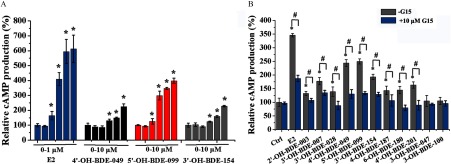Figure 4.
Effects of () and 11 hydroxylated polybrominated diphenyl ethers (OH-PBDEs) on cyclic adenosine monophosphate (cAMP) production in SKBR3 cells and the inhibitory effects of G15. (A) cAMP production induced by different concentrations of (0, , , , , and ) and OH-PBDEs (0, , , , , and ). (B) cAMP production induced by and OH-PBDEs in the absence or presence of G15, a G protein–coupled estrogen receptor antagonist. * compared with the control group (Ctrl, 0.1% dimethyl sulfoxide). # compared with the groups treated with compounds in the absence of G15.

